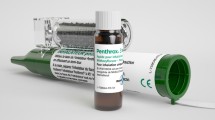Abstract
Methoxyflurane (Penthrox®) is a halogenated ether first used clinically as a volatile inhalational anaesthetic. It has been used as an analgesic in Australia and New Zealand for the past 30 years. In the UK and Europe, methoxyflurane has been approved for the emergency relief of moderate to severe trauma pain in conscious adult patients. Methoxyflurane is self-administered using a hand-held inhaler. This article reviews the pharmacological properties of methoxyflurane and its clinical efficacy and tolerability in these patients. In the phase III STOP! trial, methoxyflurane was effective and generally well tolerated for the management of acute pain due to minor trauma, with a rapid onset of analgesia. In a prospective study, methoxyflurane was more effective than intramuscular tramadol when administered for the treatment of acute musculoskeletal pain in the pre-hospital setting (i.e. by paramedics). Methoxyflurane had a more rapid onset of action than tramadol when administered for the treatment of pain related to ankle injuries in the emergency department. Although methoxyflurane is known to be potentially nephrotoxic at anaesthetic doses, the much lower doses used for pain relief were not associated with nephrotoxicity or an increased risk of renal disease. Inhaled methoxyflurane may offer advantages over other analgesics administered via the intravenous, intramuscular or intranasal routes in terms of its non-invasive self-administration, ease of use and/or rapid onset of action. As such, it is a useful additional treatment option for the management of trauma pain in the pre-hospital or emergency department setting.
Similar content being viewed by others
References
Alonso-Serra HM, Wesley K. Prehospital pain management. Prehosp Emerg Care. 2003;7(4):482–8.
Tainter CR. An evidence-based approach to traumatic pain management in the emergency department. Emerg Med Pract. 2012;14(8):1–26.
Stephen CR. Clinical applications of methoxyflurane. Acta Anaesthesiol Scand Suppl. 1966;24:215–22.
Mazze RI. Methoxyflurane revisisted: tale of an anesthetic from cradle to grave. Anesthesiology. 2006;105(4):843–6.
Medicines and Healthcare Products Regulatory Agency. Summary of product characteristics: Penthrox 3 mL inhalation vapour, liquid. 2015. https://www.mhra.gov.uk. Accessed 5 Oct 2016.
McLennan JV. Is methoxyflurane a suitable battlefield analgesic? J R Army Med Corps. 2007;153(2):111–3.
Dayan AD. Analgesic use of inhaled methoxyflurane: evaluation of its potential nephrotoxicity. Hum Exp Toxicol. 2016;35(1):91–100.
Medical Developments International Pty. Ltd. PENTHROX® (methoxyflurane) inhalation product information. 2011. http://www.megamedical.com.au. Accessed 5 Oct 2016.
Elliott JR, Elliott AA, Harper AA, et al. Effects of general anaesthetics on neuronal sodium and potassium channels. Gen Pharmacol. 1992;23(6):1005–11.
Krasowski MD, Harrison NL. The actions of ether, alcohol and alkane general anaesthetics on GABAA and glycine receptors and the effects of TM2 and TM3 mutations. Br J Pharmacol. 2000;129(4):731–43.
Oxer HF. Effects of Penthrox® (methoxyflurane) as an analgesic on cardiovascular and respiratory functions in the pre-hospital setting. J Mil Veterans Health. 2016;24(2):14–20.
Kharasch ED, Schroeder JL, Liggitt HD, et al. New insights into the mechanism of methoxyflurane nephrotoxicity and implications for anesthetic development (part 1): identification of the nephrotoxic metabolic pathway. Anesthesiology. 2006;105(4):726–36.
Kharasch ED, Schroeder JL, Liggitt HD, et al. New insights into the mechanism of methoxyflurane nephrotoxicity and implications for anesthetic development (part 2): identification of nephrotoxic metabolites. Anesthesiology. 2006;105(4):737–45.
Coffey F, Wright J, Hartshorn S, et al. STOP!: a randomised, double-blind, placebo-controlled study of the efficacy and safety of methoxyflurane for the treatment of acute pain. Emerg Med J. 2014;31(8):613–8.
Lim KJH, Koh ZX, Zafirah NA, et al. Clinical evaluation of Penthrox® (methoxyflurane) and tramadol for the Singapore emergency ambulance service [abstract plus oral presentation]. In: Society for Emergency Medicine in Singapore Annual Scientific Meeting International Resuscitation Science Symposium. 2016.
Konkayev AK, Baymagambetov S, Sainov M. Evaluation of clinical effectiveness of inhalatory analgesic «Penthrox» for pain relief in ankle injuries. Arch Balk Med Union. 2013;48(Suppl 3):239–43.
Coffey F, Dissmann P, Mirza K, et al. Methoxyflurane analgesia in adult patients in the emergency department: a subgroup analysis of a randomized, double-blind, placebo-controlled study (STOP!). Adv Ther. 2016. doi:10.1007/s12325-016-0405-7.
Jacobs IG. Health effects of patients given methoxyflurane in the pre-hospital setting: a data linkage study. TOEMJ. 2010;3:7–13.
Middleton PM, Simpson PM, Sinclair G, et al. Effectiveness of morphine, fentanyl, and methoxyflurane in the prehospital setting. Prehosp Emerg Care. 2010;14(4):439–47.
Medical Developments International. Penthrox—assessment of potential for abuse and dependency. 2013. www.medicaldev.com/wp/wp-content/…/Penthrox-AbuseDependency-Feb2013.pdf. Accessed 5 Oct 2016.
Frangos J, Mikkonnen A, Down C. Derivation of an occupational exposure limit for an inhalation analgesic methoxyflurane (Penthrox®). Regul Toxicol Pharmacol. 2016;80:210–25.
Medicines and Healthcare Products Regulatory Agency. Summary of product characteristics: Entonox. 1991. http://www.mhra.gov.uk. Accessed 5 Oct 2016.
Komesaroff D. Pre-hospital pain relief: Penthrane or Entonox? Aust J Emerg Med. 1995;2:28–9.
Acknowledgments
During the peer review process, the manufacturer of methoxyflurane was also offered an opportunity to review this article. Changes resulting from comments received were made on the basis of scientific and editorial merit.
Author information
Authors and Affiliations
Corresponding author
Ethics declarations
Funding
The preparation of this review was not supported by any external funding.
Conflicts of interest
Hannah Blair and James Frampton are salaried employees of Adis/Springer, are responsible for the article content and declare no relevant conflicts of interest.
Additional information
The manuscript was reviewed by: A. Konkayev, Astana Medical University, Astana, Kazakhstan; J. Mclennan, Emergency Medicine, Royal Stoke University Hospital, Stoke on Trent, United Kingdom; E. Nausheen, Department of Emergency Medicine, Sengkang General Hospital, Singapore.
An erratum to this article is available at http://dx.doi.org/10.1007/s40261-016-0483-y.
Rights and permissions
About this article
Cite this article
Blair, H.A., Frampton, J.E. Methoxyflurane: A Review in Trauma Pain. Clin Drug Investig 36, 1067–1073 (2016). https://doi.org/10.1007/s40261-016-0473-0
Published:
Issue Date:
DOI: https://doi.org/10.1007/s40261-016-0473-0



